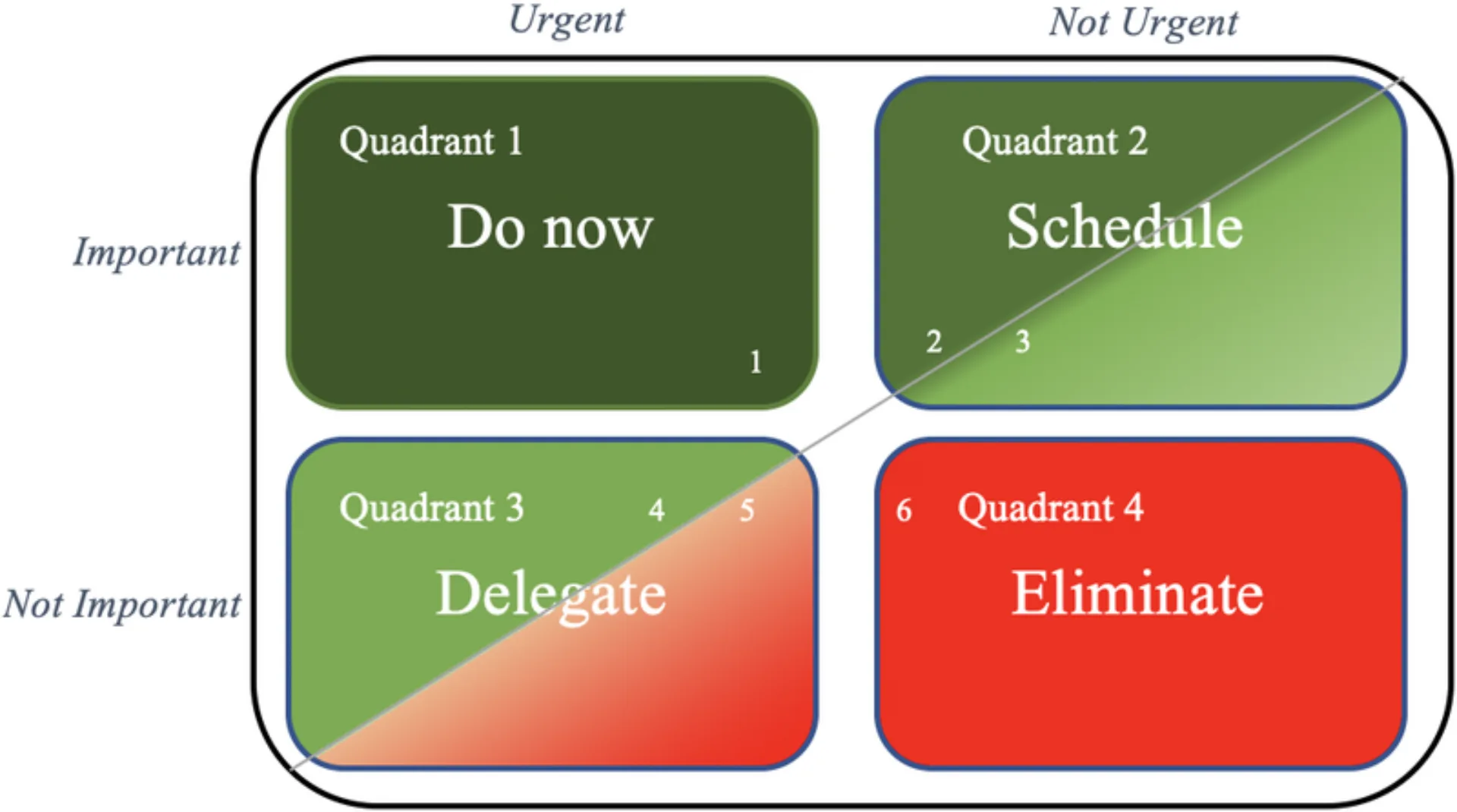Eisenhower matrix for time management
Many people struggle with prioritization decisions and find it difficult to decide what is important and which backlog item to work on next, whether it is an epic, feature, user story or task. A significant amount of time is often spent managing crisis situations and putting out fires all day. People react to others’ priorities and miss out on the truly important tasks that should have been accomplished instead. However, the most productive people stand out from the rest by the choices they make and the way they manage their time.

"What is important is seldom urgent and what is urgent is seldom important."
— Dwight D. Eisenhower, 34th President of the United States [1]
The Eisenhower matrix (also called Eisenhower decision matrix, Eisenhower box, or urgent-important matrix), popularized by Stephen R. Covey in his book “The 7 Habits of Highly Effective People”[1], is a solution to time and task management issues caused by poor prioritization. The Eisenhower decision matrix is a technique originated from Dwight D. Eisenhower, the 34th President of the United States. Later it was transformed into a four-quadrant visualization matrix that can be used by teams to prioritize tasks and backlog items. The diagram features two prioritization dimensions – importance (vertical axis) and urgency (horizontal axis) and it has four different quadrants (see Figure 1 below)[2].

Figure 1: The Eisenhower matrix
Let’s look at each of these four quadrants
Quadrant 1: Do now (urgent and important). These are items that cannot wait, potentially having strict deadlines and severe consequences for not taking immediate action[3]. These are the tasks or features that have the highest priority and should be executed first.
Some practical examples include the responsibility of providing a comprehensive report to your direct manager or higher management at the end of each week. If you do not work on Fridays and it is now Thursday morning and you have not prepared the report, this classifies as both an urgent and important task. Another example is the delivery of an important feature which is due at the end of the month (this is a hard deadline to deliver the minimum functionality requested by the client) and for which the development team has only one sprint left to finalize the delivery of the remaining work.
Quadrant 2: Schedule (important, but not urgent). Also known as “decide when you will do it” category. The work in this quadrant is important as it brings you closer to your goals. According to Covey, most of our time should be spent on activities in quadrant 2 because they provide lasting happiness, fulfillment and success. However, this work does not have a critical deadline in the near future, so it can be deferred until a later date[3]. What is essential though is to make sure you schedule a specific time (e.g. next week or month) to do these activities, so that they are done in a timely manner. Moreover, you may optionally decide to divide this quadrant into two parts if you want to distinguish the priority of the features within this “schedule” category: the requirements on the left side are of a higher priority and must be implemented first (see Figure 1).
Some examples include being the release train engineer (RTE) in a company using the scaled agile framework (SAFe) as a scaling agile method. If it is July and your first PI planning event (an important SAFe event in which all teams in an agile release train collaboratively plan and commit the work for the upcoming quarter) is in September, taking care of the logistics planning and sending an invitation to all involved participants to block their agenda is something that you need to do as soon as possible and schedule dedicated time for it. Another example is engaging in program backlog refinement with relevant teams in order to refine an important feature which is expected by the client for the upcoming quarter (consider the fact that there is still more than one month until next quarter, so this work is not urgent right now).
Quadrant 3: Delegate (urgent, but not important). The features or tasks included in this quadrant are urgent, but without a significant impact on the business aspects of a product, so the product manager or product owner must decide whether they are really needed. Usually, the tasks in this quadrant cause distraction and do not move the person or team towards the intended results and overall mission[3]. Because these “urgent” items do not represent a priority for you right now, a better strategy would be to ask yourself if there is another product area or department which should own these items and delegate accordingly. If this category is overloaded with urgent, but not important work (as it is often the case), you may want to distinguish between the different items in this category (similar to quadrant 2) by dividing the quadrant into two parts: the requirements on the left side are of a higher priority (due to higher importance or value) than those on the right (again see Figure 1).
A practical example could be unplanned work that pops up out of nowhere requesting a team member to implement an urgent user story which takes several days of work and was not planned for the sprint of this team. According to the product owner of the team, this work is not important for the completion of the sprint goal of the team for that sprint, but the backlog item is urgently needed by the requester. The recommended approach would be to explain the situation, politely reject the unplanned work and try to find if this can be delivered by another team that has capacity for the current sprint. If no other team is able to deliver the user story autonomously, check if providing guidance and direction on its completion would be sufficient (to avoid spending a few days working on an item that does not contribute to your sprint goal). Unfortunately, many people spend most of their time working on urgent, but not important for them work. These people, including product managers and product owners, often suffer from the “nice guy syndrome” and want to constantly please others even though this is at the expense of their own team’s productivity and happiness (e.g. more stress due to increased workload). Product people should understand that it is not possible to always please or satisfy all stakeholders. Instead, their job is to focus on the work that creates the desired value for the end users and the business.
Quadrant 4: Eliminate (not important and not urgent). Also known as “delete” quadrant. This is not important and not urgent work, so you should avoid doing this type of work, at least for your short- and medium-term planning (or if not possible, try to spend a very limited amount of time on these tasks). The features in this quadrant are usually a waste of time, as they provide no value and are not worth the investment[3]. An example would be a delivery of a feature that requires a very big investment, but only a few people are willing to use, which does not make up a good business case.
Let’s now look at the pros and cons of the Eisenhower matrix
Pros of the Eisenhower matrix
- It is a simple technique. It is a simple prioritization method, and priorities can be identified quickly. If you do not have many tasks or features to go in quadrant 2 or 3, you don’t have to divide these quadrants into two parts (as shown on Figure 1)
- Decide the priorities of the work that really matters. The method is great to better manage your own and your team’s time, to organize your work effectively and eventually become more productive. Always think why you are implementing a feature or a backlog item you have prioritized, whether it is because it is really important or simply because it is an urgent request coming from someone else higher up in the organization. Always bear in mind that importance is a choice, while urgency is a matter of time
- The method can be applied to both professional and personal life. The method can be used not only for individuals to manage their specific personal tasks, but it is also business centric. Higher priority is given to those features or other backlog items that are more relevant and useful from a business point of view. This avoids the common risk of always doing urgent work, instead of looking at the bigger picture and prioritizing important items with a strategic and long-term impact
Cons of the Eisenhower matrix
- Not based on concrete data or evidence. The Eisenhower decision matrix is not a data-driven approach. It does not need any calculations, metrics or other actionable insights. It is a simple technique, but some misconceptions or discussions may occur within the product team on why the defined priorities are chosen like that
- Lack of focus on technical aspect. The technique is focused on the business aspect of the product. However, this prioritization method may miss the technical aspect (e.g. how much time it takes to deliver a feature even though it is considered as important, but also whether the implementation is technically feasible in the first place), which may delay the project and affect the overall product flow
When to use the Eisenhower matrix
The Eisenhower matrix is a great decision-making tool used for effective time management and a model to help you make choices and set priorities. The beauty of the matrix is that it can be applied to both your personal and professional life. From a professional point of view, it can be used as a prioritization technique to allocate work across four categories based on the dimensions of importance and urgency. It is a useful framework to avoid the so-called “urgency trap” (i.e. wasting time working on or delivering “urgent” things, which do not have to be addressed right now and might not deserve your attention at all, instead of tackling valuable and important tasks that help you move closer to your goals) and focus on what really matters. However, due to the limitations discussed above, it is better suited for prioritizing individual tasks or work, given that there are more sophisticated methods (but also more complicated and time consuming) to prioritize big epics and features for your product. If this method is used to prioritize the whole product or program backlog, the entire delivery team must understand and agree on the requirements, including their urgency and priority.
References:
[1] Covey, S. R. (2013). The 7 habits of highly effective people: Powerful lessons in personal change. Simon and Schuster.
[2] Krogerus, M., & Tschäppeler, R. (2012). The decision book: 50 models for strategic thinking. WW Norton & Company.
[3] McKay, B. (2013, October 23). The Eisenhower Decision Matrix: How to Distinguish Between Urgent and Important Tasks. Retrieved from artofmanliness.com
Related insights
